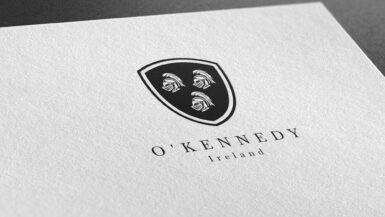Origin of the Surname
The Nangle surname, or in its Gaelic form, de Nógla, stands out in Irish genealogy not just for its unique phonetics but also for its significant historical implications. With deep medieval roots, this name paints a rich picture of the Anglo-Norman influence in Ireland.
Etymology and Meaning
The Nangle name, stemming from de Nógla, is believed to be of Norman origin. It’s derived from the Old Norman ‘de Angulo’, which translates to “from the corner” or “of the angle.”
Earliest Known Usage
The earliest records of the Nangle surname in Ireland are intertwined with the Norman invasion of the 12th century. The family was part of the initial wave of Norman settlers, securing land and title under the auspices of the invading forces.
Geographic Distribution
Historically, the Nangle family was concentrated in the eastern and western parts of Ireland. Their influence was particularly felt in County Mayo and County Meath.
Original Geographic Location
Upon their arrival in Ireland during the Norman invasion, the Nangles first established themselves in what is now modern-day County Meath. From there, they expanded their territories, eventually making significant settlements in County Mayo.
Migration Patterns
Over the centuries, the Nangle name, like many Irish surnames, experienced migrations and dispersals. Due to political unrest, land disputes, and economic hardships, many members of the Nangle clan migrated within Ireland, with some venturing overseas to destinations like England, the U.S., and Australia.
Historical Context
Notable Historical Events
The history of the Nangles in Ireland is closely linked to the broader narrative of Norman settlers. Their rise to prominence came with the successful Norman invasion, and their legacy was intertwined with the subsequent shaping of Irish medieval society.
Involvement in Key Moments in History
The Nangle family, upon their arrival and settlement, played a critical role in establishing Norman structures, fortifications, and societal norms in their regions of influence, particularly in County Meath and County Mayo.
Notable Irish Bearers of the Surname
Famous Individuals
- Jocelyn de Angulo (or Nangle): One of the earliest known Nangle figures, Jocelyn was among the Norman knights who arrived in Ireland in the 12th century. He was granted lands in Meath and became the progenitor of the Nangle lineage in Ireland.
Influential Bearers of the Nagle Surname
While the Nagle name traces its origins to the rich tapestry of Irish history, it has also been borne by figures whose influence has transcended the boundaries of their surname. Let’s delve into the lives and legacies of two such individuals: Nano Nagle and Richard Nagle.
Nano Nagle (1718-1784)
The Torchbearer of Education
Born during a time when Ireland was under the oppressive Penal Laws, which suppressed the rights of Catholics, Nano Nagle’s legacy is one of resilience and rebellion in the face of adversity.
Early Life: Born in Ballygriffin, County Cork, Nano was part of a well-off family. Recognizing the importance of education and the limitations in Ireland, her parents sent her to France for her studies. There, she was not only introduced to the world of knowledge but also deeply influenced by the French spiritual movements of the time.
Founding the Sisterhood: On her return to Ireland, Nagle was moved by the plight of the poor, especially the lack of educational opportunities for children. In defiance of the laws of the time, she set up clandestine schools across Cork. These establishments, often hidden and operating in secrecy, were the early precursors to a more formal educational movement.
Beyond education, Nano’s concerns extended to the elderly and sick, for whom she would often care after her teaching hours, earning her the nickname the “Lady with the Lantern”.
Legacy: Realizing the need for a more sustainable solution, Nagle founded the “Sisters of the Presentation of the Blessed Virgin Mary” in 1775. This congregation of nuns would not only uphold her mission of education but also ensure that the flame she lit would continue to shine. Today, Presentation schools, inspired by Nano Nagle’s vision, operate worldwide.
Richard Nagle (c. 1636-1699)
The Legal Mind and Political Strategist
In a contrasting sphere of influence, Richard Nagle stands out as a legal and political figure during one of Ireland’s most tumultuous periods.
Early Life & Education: Born in County Meath, Nagle’s early years positioned him for a future in law and governance. Educated at the Irish College in Paris and the Middle Temple in London, he returned to Ireland as a barrister with a keen sense of the political landscapes of his time.
Political Involvement: As the Penal Laws weighed heavily on Irish Catholics, Nagle became a key figure in the Catholic resistance. His legal expertise and political acumen saw him draft the seminal “Remonstrance of the Irish Catholics” in 1687, a document that voiced the grievances of the oppressed Catholic majority.
During the reign of the Catholic King James II, Nagle was appointed Attorney General for Ireland and later, the Speaker of the Patriot Parliament of 1689 in Dublin.
Legacy: While King James II’s reign in Ireland was short-lived, and the subsequent Williamite victory saw the imposition of even stricter anti-Catholic laws, Nagle’s contributions were not forgotten. He remains a symbol of resistance, a legal luminary, and a beacon for the rights of Irish Catholics.
Variations of the Surname
Spelling Variations
Over the years, the Nangle surname has experienced various spelling adaptations. Some of these include Nagle, Naigle, and Neagle.
Regional Differences
Depending on the region, especially in areas outside of Ireland, the phonetic variations of the name might become more pronounced. For instance, “Nagle” could be more prevalent in American records, while “Nangle” remains a staple in Irish chronicles.
Current Statistics and Distribution
Frequency and Global Distribution
The Nangle name, while rooted deeply in Irish history, has seen a global spread, primarily due to diasporic movements. Its presence can be felt in countries with significant Irish populations, such as the U.S., Canada, Australia, and parts of the UK.
Changes Over Time
While the Nangle name remains recognizable in Ireland, its frequency has diminished in certain regions, especially where the family originally held substantial influence. The global dispersal of the name, however, has ensured its survival and propagation in foreign lands.
Family Coat of Arms
The Nangle family boasts a coat of arms reflective of its Norman origins and its foundational status in medieval Ireland. The emblem features a shield divided into quadrants, with alternating patterns of gold and blue. At the center, a red cross signifies faith and valor. The crest, atop the shield, showcases an armored arm holding a five-pointed star, symbolizing divine guidance and martial prowess.






Leave a reply